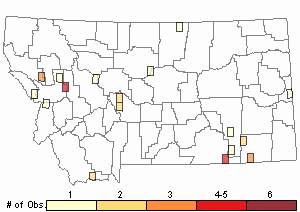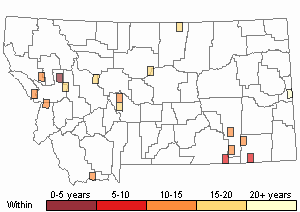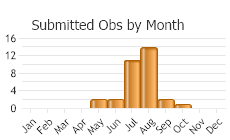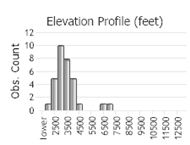View in other NatureServe Network Field Guides
NatureServe
Montana
Utah
Wyoming
Idaho
Wisconsin
British Columbia
South Carolina
Yukon
California
New York
Grooved Fingernailclam - Sphaerium simile
General Description
Fingernail clams are small "mostly about the size of a finger or thumbnail" bottom-dwelling, filter-feeders found in ponds, lakes and streams throughout Montana. They are native and can be quite abundant, providing food for a variety of animals and producing large accumulations of empty shells. These shells can be quite fragile compared to introduced Asian clams of the family Corbiculidae, which have not been reported in Montana, yet.
Diagnostic Characteristics
Shell suborbicular convex, base a little flattened; with nearly equidistant, raised, concentric lines, giving a sulcated appearance to the surface, and generally a more conspicuous elevated darker wave, marking the former year's growth of the shell. Epidermis brown or ferruginous; beak nearer central and obtuse; hinge with minute very oblique teeth, lateral ones very distinct, elongated, and considerably resembling those of C. dubia. Length, seven-twentieths of an inch; breadth, two-fifths (Herrington and Taylor 1958). (La Rocque 1967) cites dimensions of: L. 9, breadth 10 mm. Very Similar to S. sulcatum (La Rocque 1967).
Species Range
Montana Range
Range Descriptions

 Native
Native
Range Comments
Southern Canada from New Brunswick to northern and central British Columbia, and south to Virginia, Iowa, and Wyoming (Burch 1972).
Observations in Montana Natural Heritage Program Database
Number of Observations: 33
(Click on the following maps and charts to see full sized version)
Map Help and Descriptions
Relative Density

Recency



 (Observations spanning multiple months or years are excluded from time charts)
(Observations spanning multiple months or years are excluded from time charts)
Habitat
Occurs in perennial-water habitats that contain submersed vegetation and muddy or sandy bottoms (Clarke 1981).
Food Habits
Fingernail clams are mostly filter-feeders, siphoning in floating particulate organic materials ( small plant or animal) from the water column and straining out the particles and expel the strained water. Pedal feeding from the bottom with the foot muscle has also been observed.
Reproductive Characteristics
A few young of different sizes are present in most adult specimens. The maximum life span of the species has been estimated at about 8 years (Clarke 1981).
Stewardship Responsibility
References
- Literature Cited AboveLegend:
 View Online Publication
View Online Publication Burch, J.B. 1972. Freshwater Sphaeriacean clams (Mollusca:Pelecypoda) of North America. EPA Biota of Freshwater Ecosystems Identification Manual No. 3. 31 pp.
Burch, J.B. 1972. Freshwater Sphaeriacean clams (Mollusca:Pelecypoda) of North America. EPA Biota of Freshwater Ecosystems Identification Manual No. 3. 31 pp. Clarke, A.H. 1981. The freshwater molluscs of Canada. National Museum of Natural Sciences, National Museums of Canada, Ottawa. 446 pp.
Clarke, A.H. 1981. The freshwater molluscs of Canada. National Museum of Natural Sciences, National Museums of Canada, Ottawa. 446 pp. Elrod, M.J. 1902. A biological reconnoissance in the vicinity of Flathead Lake. Bulletin of the University of Montana Number, Biological Series 10(3):89-182.
Elrod, M.J. 1902. A biological reconnoissance in the vicinity of Flathead Lake. Bulletin of the University of Montana Number, Biological Series 10(3):89-182. Henderson, J. 1924. Mollusca of Colorado, Utah, Montana, Idaho, and Wyoming. University of Colorado Studies 13(2):65-223.
Henderson, J. 1924. Mollusca of Colorado, Utah, Montana, Idaho, and Wyoming. University of Colorado Studies 13(2):65-223. Herrington, H.B. and D.W. Taylor. 1958. Pliocene and Pleistocene Sphaeriidae (Pelecypoda) from the central United States. Occasional Papers of the Museum of Zoology University of Michigan. 596.
Herrington, H.B. and D.W. Taylor. 1958. Pliocene and Pleistocene Sphaeriidae (Pelecypoda) from the central United States. Occasional Papers of the Museum of Zoology University of Michigan. 596. La Rocque, A. 1967. Pleistocene Mollusca of Ohio. Department of Natural Resources, Division of Geological Survey Bulletin 62, Part 2. 113-365 + 8 plates.
La Rocque, A. 1967. Pleistocene Mollusca of Ohio. Department of Natural Resources, Division of Geological Survey Bulletin 62, Part 2. 113-365 + 8 plates.
- Additional ReferencesLegend:
 View Online Publication
View Online Publication
Do you know of a citation we're missing? Gore, J. A. 1976. In-stream flow requirements of benthic macroinvertebrates in a prairie river. M.A. thesis. University of Montana, Missoula, MT.
Gore, J. A. 1976. In-stream flow requirements of benthic macroinvertebrates in a prairie river. M.A. thesis. University of Montana, Missoula, MT. Squyer, H. 1894. List of shells from the vicinity of Mingusville, Montana. The Nautilus 8:63-65.
Squyer, H. 1894. List of shells from the vicinity of Mingusville, Montana. The Nautilus 8:63-65.
- Web Search Engines for Articles on "Grooved Fingernailclam"
- Additional Sources of Information Related to "Mussels / Clams"





